MaryAnn Bernal's Blog, page 213
December 8, 2014
History Trivia - first Shakespearian actress appears on an English stage as Desdemona
December 8
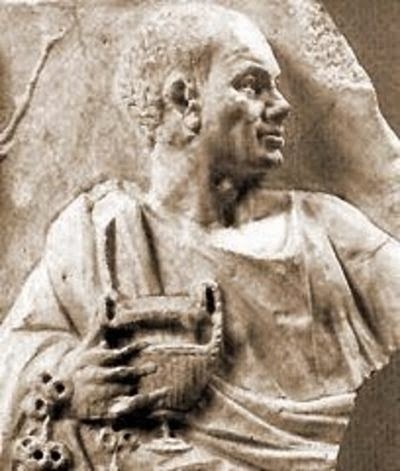
65 BC Horace (Quintus Horatius Flaccus) was born. He was one of the most familiar and admired of the Roman poets.

877 Louis II, the Stammerer, was crowned King of France.

1542 Mary, Queen of Scots was born.

1609 Biblioteca Ambrosiana (Milan Italy) opened its reading room, the second public library of Europe.

1660 The first Shakespearian actress to appear on an English stage (believed to be a Ms. Norris) made her debut as Desdemona in Shakespeare's Othello.


65 BC Horace (Quintus Horatius Flaccus) was born. He was one of the most familiar and admired of the Roman poets.

877 Louis II, the Stammerer, was crowned King of France.

1542 Mary, Queen of Scots was born.

1609 Biblioteca Ambrosiana (Milan Italy) opened its reading room, the second public library of Europe.

1660 The first Shakespearian actress to appear on an English stage (believed to be a Ms. Norris) made her debut as Desdemona in Shakespeare's Othello.

Published on December 08, 2014 04:30
December 7, 2014
Happy Holidays from Whispering Legends Press
Merry Christmas and Happy New Year
Whispering Legends Press
Whispering Legends Pressfeatured author Mary Ann Bernal

Whispering Legends Press

Whispering Legends Pressfeatured author Mary Ann Bernal


Published on December 07, 2014 16:08
Remembering Pearl Harbor - 73rd anniversary of the Japanese attack on December 7, 1941
 Pearl Harbor Raid, 7 December 1941
Pearl Harbor Raid, 7 December 1941 Overview and Special Image Selection
Navy History
The 7 December 1941 Japanese raid on Pearl Harbor was one of the great defining moments in history. A single carefully-planned and well-executed stroke removed the United States Navy's battleship force as a possible threat to the Japanese Empire's southward expansion. America, unprepared and now considerably weakened, was abruptly brought into the Second World War as a full combatant.
Eighteen months earlier, President Franklin D. Roosevelt had transferred the United States Fleet to Pearl Harbor as a presumed deterrent to Japanese agression. The Japanese military, deeply engaged in the seemingly endless war it had started against China in mid-1937, badly needed oil and other raw materials. Commercial access to these was gradually curtailed as the conquests continued. In July 1941 the Western powers effectively halted trade with Japan. From then on, as the desperate Japanese schemed to seize the oil and mineral-rich East Indies and Southeast Asia, a Pacific war was virtually inevitable.
By late November 1941, with peace negotiations clearly approaching an end, informed U.S. officials (and they were well-informed, they believed, through an ability to read Japan's diplomatic codes) fully expected a Japanese attack into the Indies, Malaya and probably the Philippines. Completely unanticipated was the prospect that Japan would attack east, as well.
The U.S. Fleet's Pearl Harbor base was reachable by an aircraft carrier force, and the Japanese Navy secretly sent one across the Pacific with greater aerial striking power than had ever been seen on the World's oceans. Its planes hit just before 8AM on 7 December. Within a short time five of eight battleships at Pearl Harbor were sunk or sinking, with the rest damaged. Several other ships and most Hawaii-based combat planes were also knocked out and over 2400 Americans were dead. Soon after, Japanese planes eliminated much of the American air force in the Philippines, and a Japanese Army was ashore in Malaya.
These great Japanese successes, achieved without prior diplomatic formalities, shocked and enraged the previously divided American people into a level of purposeful unity hardly seen before or since. For the next five months, until the Battle of the Coral Sea in early May, Japan's far-reaching offensives proceeded untroubled by fruitful opposition. American and Allied morale suffered accordingly. Under normal political circumstances, an accomodation might have been considered.
However, the memory of the "sneak attack" on Pearl Harbor fueled a determination to fight on. Once the Battle of Midway in early June 1942 had eliminated much of Japan's striking power, that same memory stoked a relentless war to reverse her conquests and remove her, and her German and Italian allies, as future threats to World peace.
This page features a historical overview and special image selection on the Pearl Harbor raid, chosen from the more comprehensive coverage featured in the following pages, and those linked from them:
Pearl Harbor in 1940-1941Japanese Forces in the Pearl Harbor AttackOverall Views of the Pearl Harbor Attack
"Battleship Row" during the Pearl Harbor AttackAttacks off the West Side of Ford IslandAttacks in the Navy Yard AreaAttacks on Airfields and Aerial Combat
Other Raid-related EventsDamaged Ships after the Attack
Raid AftermathPost-Attack Ship SalvageRemembrance of the "Day which will live in Infamy"For additional information and related resources on the Pearl Harbor attack, see
The Pearl Harbor Attack, 7 December 1941 and WWII Pacific Battles
Click photograph for larger image.
Photo #: NH 50603
Pearl Harbor Attack, 7 December 1941
A Japanese Navy Type 97 Carrier Attack Plane ("Kate") takes off from a carrier as the second wave attack is launched. Ship's crewmen are cheering "Banzai"
This ship is either Zuikaku or Shokaku.
Note light tripod mast at the rear of the carrier's island, with Japanese naval ensign.
NHHC Photograph
Online Image: 57KB; 740 x 540
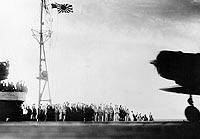 Photo #: NH 50931
Photo #: NH 50931Pearl Harbor Attack, 7 December 1941
Torpedo planes attack "Battleship Row" at about 0800 on 7 December, seen from a Japanese aircraft. Ships are, from lower left to right: Nevada (BB-36) with flag raised at stern; Arizona (BB-39) with Vestal (AR-4) outboard; Tennessee (BB-43) with West Virginia (BB-48) outboard; Maryland (BB-46) with Oklahoma (BB-37) outboard; Neosho (AO-23) and California (BB-44).
West Virginia, Oklahoma and California have been torpedoed, as marked by ripples and spreading oil, and the first two are listing to port. Torpedo drop splashes and running tracks are visible at left and center.
White smoke in the distance is from Hickam Field. Grey smoke in the center middle distance is from the torpedoed USS Helena (CL-50), at the Navy Yard's 1010 dock.
Japanese writing in lower right states that the image was reproduced by authorization of the Navy Ministry.
NHHC Photograph
Online Image: 144KB; 740 x 545
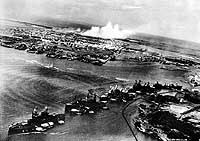 Photo #: 80-G-266626
Photo #: 80-G-266626USS Utah (AG-16)
Capsizing off Ford Island, during the attack on Pearl Harbor, 7 December 1941, after being torpedoed by Japanese aircraft .
Photographed from USS Tangier (AV-8), which was moored astern of Utah.
Note colors half-raised over fantail, boats nearby, and sheds covering Utah's after guns.
Official U.S. Navy Photograph, National Archives collection
Online Image: 83KB; 740 x 605
Reproductions may also be available at National Archives.
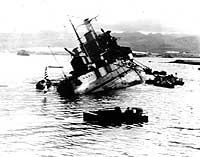 Photo #: 80-G-K-13513 (Color)
Photo #: 80-G-K-13513 (Color)Pearl Harbor Attack, 7 December 1941
The forward magazines of USS Arizona (BB-39) explode after she was hit by a Japanese bomb, 7 December 1941.
Frame clipped from a color motion picture taken from on board USS Solace (AH-5).
Official U.S. Navy Photograph, National Archives collection
Online Image: 55KB; 740 x 610
Reproductions may also be available at National Archives.
Note: The motion picture from which this image is taken is shown backwards, with the fireball oriented to the left. The image is correctly oriented as shown here.
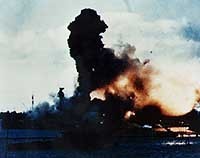 Photo #: 80-G-19942
Photo #: 80-G-19942Pearl Harbor Attack, 7 December 1941
USS Arizona (BB-39) sunk and burning furiously, 7 December 1941. Her forward magazines had exploded when she was hit by a Japanese bomb.
At left, men on the stern of USS Tennessee (BB-43) are playing fire hoses on the water to force burning oil away from their ship
Official U.S. Navy Photograph, National Archives collection
Online Image: 115KB; 740 x 610
Reproductions may also be available at National Archives.
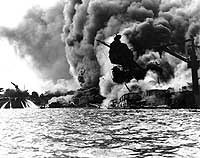 Photo #: 80-G-19930
Photo #: 80-G-19930Pearl Harbor Attack, 7 December 1941
Sailors in a motor launch rescue a survivor from the water alongside the sunken USS West Virginia (BB-48) during or shortly after the Japanese air raid on Pearl Harbor.
USS Tennessee (BB-43) is inboard of the sunken battleship.
Note extensive distortion of West Virginia's lower midships superstructure, caused by torpedoes that exploded below that location.
Also note 5"/25 gun, still partially covered with canvas, boat crane swung outboard and empty boat cradles near the smokestacks, and base of radar antenna atop West Virginia's foremast.
Official U.S. Navy Photograph, National Archives collection
Online Image: 119KB; 740 x 620
Reproductions may also be available at National Archives.
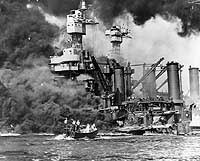 Photo #: 80-G-19949
Photo #: 80-G-19949Pearl Harbor Attack, 7 December 1941
USS Maryland (BB-46) alongside the capsized USS Oklahoma (BB-37).
USS West Virginia (BB-48) is burning in the background.
Official U.S. Navy Photograph, National Archives collection.
Online Image: 88KB; 740 x 605
Reproductions may also be available at National Archives.
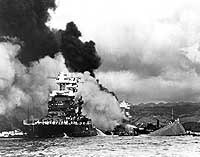 Photo #: NH 86118
Photo #: NH 86118Pearl Harbor Attack, 7 December 1941
The forward magazine of USS Shaw (DD-373) explodes during the second Japanese attack wave. To the left of the explosion, Shaw's stern is visible, at the end of floating drydock YFD-2.
At right is the bow of USS Nevada (BB-36), with a tug alongside fighting fires.
Photographed from Ford Island, with a dredging line in the foreground.
NHHC Photograph
Online Image: 99KB; 740 x 605
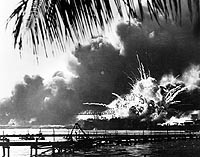 Photo #: 80-G-19943
Photo #: 80-G-19943Pearl Harbor Attack, 7 December 1941
The wrecked destroyers USS Downes (DD-375) and USS Cassin (DD-372) in Drydock One at the Pearl Harbor Navy Yard, soon after the end of the Japanese air attack. Cassin has capsized against Downes.
USS Pennsylvania (BB-38) is astern, occupying the rest of the drydock. The torpedo-damaged cruiser USS Helena (CL-50) is in the right distance, beyond the crane. Visible in the center distance is the capsized USS Oklahoma (BB-37), with USS Maryland (BB-46) alongside. Smoke is from the sunken and burning USS Arizona (BB-39), out of view behind Pennsylvania. USS California (BB-44) is partially visible at the extreme left.
This image has been attributed to Navy Photographer's Mate Harold Fawcett.
Official U.S. Navy Photograph, National Archives collection
Online Image: 158KB; 610 x 765
Reproductions may also be available at National Archives.
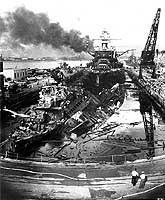 Photo #: 80-G-32836
Photo #: 80-G-32836Pearl Harbor Attack, 7 December 1941
PBY patrol bomber burning at Naval Air Station Kaneohe, Oahu, during the Japanese attack.
Official U.S. Navy Photograph, National Archives collection
Online Image: 91KB; 740 x 605
Reproductions may also be available at National Archives.
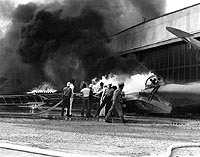 Photo #: NH 72273-KN (Color)
Photo #: NH 72273-KN (Color)"Remember Dec. 7th!"
Poster designed by Allen Sandburg, issued by the Office of War Information, Washington, D.C., in 1942, in remembrance of the Japanese Attack on Pearl Harbor on 7 December 1941.
The poster also features a quotation from Abraham Lincoln's Gettysburg Address: "... we here highly resolve that these dead shall not have died in vain ...".
Courtesy of the U.S. Navy Art Center. Donation of Dr. Robert L. Scheina, 1970.
NHHC Photograph
Online Image: 83KB; 525 x 765
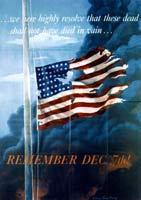

Published on December 07, 2014 04:30
History Trivia - Cicero executed on the orders of Mark Antony
December 7,
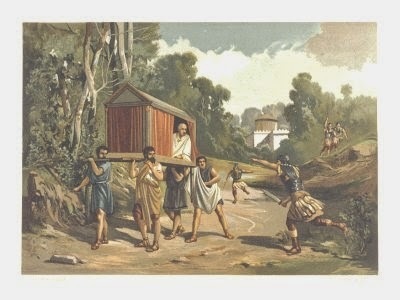
43 BC Roman orator and advocate Cicero was executed on the orders of Mark Antony.

983 German King Otto III took the throne after his father's death in Italy. He was the fourth ruler of the Saxon (Ottonian) dynasty of the Holy Roman Empire, being crowned Holy Roman Emperor in 997.

1254 Pope Innocent IV died. The pontificate of Innocent was marked by a long struggle with Holy Roman Emperor Frederick II, characteristic of the conflict between empire and papacy.


43 BC Roman orator and advocate Cicero was executed on the orders of Mark Antony.

983 German King Otto III took the throne after his father's death in Italy. He was the fourth ruler of the Saxon (Ottonian) dynasty of the Holy Roman Empire, being crowned Holy Roman Emperor in 997.

1254 Pope Innocent IV died. The pontificate of Innocent was marked by a long struggle with Holy Roman Emperor Frederick II, characteristic of the conflict between empire and papacy.

Published on December 07, 2014 04:30
December 6, 2014
Mysterious 'Ghost' Ship Rediscovered Near Hawaii
by Tia Ghose, LiveScience

The U.S.S. Kailua, a sunken cable repair ship that was torpedoed in 1946, was recently rediscovered off the shores of Oahu, Hawaii. The ship's wheel, shown here, was still in its original location.
A "ghost ship" that has been lost beneath the waves for more than 60 years has been discovered nearly a half-mile below the ocean surface off the Hawaiian island of Oahu.
A small submersible vehicle came upon the shipwreck last year, researchers at the University of Hawaii announced today (Dec. 5). Despite being torpedoed after World War II, many parts of the ship, including the ship's wheel, are still in their original locations.
"The upper deck structures from the bow to the stern were well-preserved and showed no sign of torpedo damage," Terry Kerby, a submersible pilot with the university's Hawai'i Undersea Research Laboratory, said in a statement. [Shipwrecks Gallery: Secrets of the Deep]
Biggest Shipwreck Finds in History
Vast submarine network
The ship, then called the Dickenson, first set sail in early 1923 as part of a fleet of ships that maintained the growing submarine telecommunications network at the time. The ship set out from Chester, Pennsylvania, as part of the Commercial Pacific Cable Company fleet, and arrived in Hawaii in July of that year.
The Dickenson ferried supplies and patched up cables at the remote Midway and Fanning Islands from 1923 to 1941. Then, soon after the bombing of Pearl Harbor on Dec. 7, 1941, the Dickenson evacuated British employees of the telecommunications company Cable and Wireless Ltd., from Midway Island, ferrying them back to Oahu. Some of the evacuees even spotted a submarine tailing their ship, before American ships chased it away.
During the war, the Midway Island telecommunications hub stopped functioning, and the Dickenson was renamed the U.S.S. Kailua and was sent to maintain cables in other locales in the South Pacific.
After the war, the ship returned to Pearl Harbor, but neither the Navy nor its original owners wanted it. On Feb. 7, 1946, the ship was torpedoed and sunk into the deep waters off Oahu, but no one recorded its final resting place.
"From her interisland service to her role in Pacific communications and then World War II, Dickenson today is like a museum exhibit resting in the darkness, reminding us of these specific elements of Pacific history," said Hans Van Tilburg, a researcher with the maritime heritage program in the National Oceanic and Atmospheric Administration's Office of Marine Sanctuaries.
Easy ID
The team came across the WWII ship by accident last year. The shipwreck was about 2,000 feet (609 meters) below the water's surface and was still sitting upright, with its lone mast still pointing upward and the wheel still intact.
Photos: Diving Into a Mediterranean Shipwreck
"It is always a thrill when you are closing in on a large sonar target with the Pisces submersible, and you don't know what big piece of history is going to come looming out of the dark," Kerby said.
Almost everything on the ship was still in place, and the identification was easy -- the navy ship number, IX-71, was still visible on the ship's bow.


The U.S.S. Kailua, a sunken cable repair ship that was torpedoed in 1946, was recently rediscovered off the shores of Oahu, Hawaii. The ship's wheel, shown here, was still in its original location.
A "ghost ship" that has been lost beneath the waves for more than 60 years has been discovered nearly a half-mile below the ocean surface off the Hawaiian island of Oahu.
A small submersible vehicle came upon the shipwreck last year, researchers at the University of Hawaii announced today (Dec. 5). Despite being torpedoed after World War II, many parts of the ship, including the ship's wheel, are still in their original locations.
"The upper deck structures from the bow to the stern were well-preserved and showed no sign of torpedo damage," Terry Kerby, a submersible pilot with the university's Hawai'i Undersea Research Laboratory, said in a statement. [Shipwrecks Gallery: Secrets of the Deep]
Biggest Shipwreck Finds in History
Vast submarine network
The ship, then called the Dickenson, first set sail in early 1923 as part of a fleet of ships that maintained the growing submarine telecommunications network at the time. The ship set out from Chester, Pennsylvania, as part of the Commercial Pacific Cable Company fleet, and arrived in Hawaii in July of that year.
The Dickenson ferried supplies and patched up cables at the remote Midway and Fanning Islands from 1923 to 1941. Then, soon after the bombing of Pearl Harbor on Dec. 7, 1941, the Dickenson evacuated British employees of the telecommunications company Cable and Wireless Ltd., from Midway Island, ferrying them back to Oahu. Some of the evacuees even spotted a submarine tailing their ship, before American ships chased it away.
During the war, the Midway Island telecommunications hub stopped functioning, and the Dickenson was renamed the U.S.S. Kailua and was sent to maintain cables in other locales in the South Pacific.
After the war, the ship returned to Pearl Harbor, but neither the Navy nor its original owners wanted it. On Feb. 7, 1946, the ship was torpedoed and sunk into the deep waters off Oahu, but no one recorded its final resting place.
"From her interisland service to her role in Pacific communications and then World War II, Dickenson today is like a museum exhibit resting in the darkness, reminding us of these specific elements of Pacific history," said Hans Van Tilburg, a researcher with the maritime heritage program in the National Oceanic and Atmospheric Administration's Office of Marine Sanctuaries.
Easy ID
The team came across the WWII ship by accident last year. The shipwreck was about 2,000 feet (609 meters) below the water's surface and was still sitting upright, with its lone mast still pointing upward and the wheel still intact.
Photos: Diving Into a Mediterranean Shipwreck
"It is always a thrill when you are closing in on a large sonar target with the Pisces submersible, and you don't know what big piece of history is going to come looming out of the dark," Kerby said.
Almost everything on the ship was still in place, and the identification was easy -- the navy ship number, IX-71, was still visible on the ship's bow.

Published on December 06, 2014 08:26
History Trivia - Saint-Nicolas Flood damages Northern Dutch Coast
December 6

1196 the Northern Dutch coast was flooded; known as the Saint-Nicolas Flood, resulted in widespread damage and death.
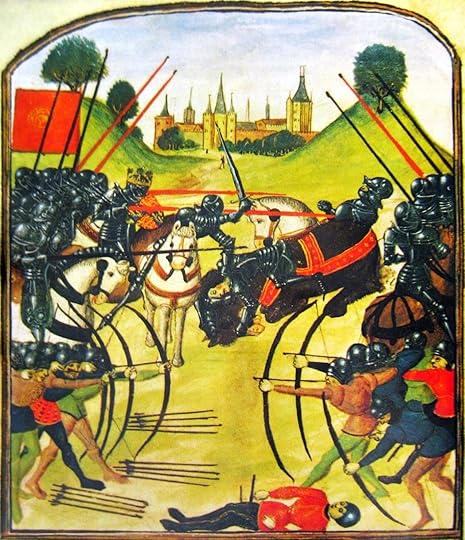
1421 Henry VI was born. Henry VI was a child when he came to the throne on the death of his father Henry V. His weakness as a ruler and his occasional displays of mental instability exacerbated the Wars of the Roses (dynastic civil wars for the throne of England fought between supporters of two rival branches of the royal House of Plantagenet: the houses of Lancaster and York).


1196 the Northern Dutch coast was flooded; known as the Saint-Nicolas Flood, resulted in widespread damage and death.

1421 Henry VI was born. Henry VI was a child when he came to the throne on the death of his father Henry V. His weakness as a ruler and his occasional displays of mental instability exacerbated the Wars of the Roses (dynastic civil wars for the throne of England fought between supporters of two rival branches of the royal House of Plantagenet: the houses of Lancaster and York).

Published on December 06, 2014 04:30
December 5, 2014
Scribbler’s Tales (Audio) by Mary Ann Bernal featured on A Woman's World
 December 5, 2014 by A Woman's Wisdom
December 5, 2014 by A Woman's Wisdom A Woman's Wisdom
New Release: Scribbler’s Tales (Audio) by Mary Ann Bernal
 Mary Ann Bernal, author of The Briton and the Dane novels, is an avid history buff whose area of interest focuses on Ninth Century Anglo-Saxon Britain during the Viking Age. While pursuing a degree in business administration, she managed to fit creative writing classes and workshops into her busy schedule to learn the craft, but it would take decades before her “Erik the Viking” novel was ultimately published.
Mary Ann Bernal, author of The Briton and the Dane novels, is an avid history buff whose area of interest focuses on Ninth Century Anglo-Saxon Britain during the Viking Age. While pursuing a degree in business administration, she managed to fit creative writing classes and workshops into her busy schedule to learn the craft, but it would take decades before her “Erik the Viking” novel was ultimately published.Mary Ann is also a passionate supporter of the United States military, having been involved with letter writing campaigns and other support programs since Operation Desert Storm. She has appeared on The Morning Blend television show hosted by KMTV, the CBS television affiliate in Omaha, and was interviewed by the Omaha World-Herald for her volunteer work. She has also been a featured author on Triangle Variety Radio, The Phil Naessens Show, and The Writers Showcase, and has been interviewed extensively by American and European bloggers.
Mary Ann currently resides in Omaha, Nebraska.
Something a little different this week – Mary Ann Bernal has released an audio version of her anthology Scribbler’s Tales. You can contact Mary Ann on her website, Twitter and Goodreads. Free copy offered has been grabbed by Barb Taub. Enjoy, Barb!
 Book Blurb“Scribbler Tales is a unique mix of genres in one anthology rich with tension, humanity and genuine emotion. Unconventional settings and unexpected twists are bound to leave you pondering long after you close this book.”
Book Blurb“Scribbler Tales is a unique mix of genres in one anthology rich with tension, humanity and genuine emotion. Unconventional settings and unexpected twists are bound to leave you pondering long after you close this book.”In Desperate Measures, Audrey learns of Paul’s duplicity when human cloning experiments go awry. Forbidden Lore beckons Arianna and Ethan into a haunted cemetery where they are confronted by a gathering of witches with evil intent . Adrian must challenge his father to marry Rina or suffer the fate of star-crossed lovers in Forever Lost. In The Hourglass, Flair makes a covenant with the Devil to keep Brice alive. Aaron reflects upon his childhood as a military brat in Sail with Me.
Desperate Measures Audrey stood on the ledge of the roof overlooking the flower beds as a gentle breeze carried the pleasant fragrances across the well-kept lawn. She should have seen through the deception, but then, hindsight is an excellent teacher. His betrayal had stung, affecting her very soul because she had believed him, refusing to recognize his faults, and there were many. Paul had seduced her, even though she had been a willing participant, believing his every word.“Paul is too selfish with an ego the size of Texas! Whatever were you thinking? Father was right … I am book smart, but not streetwise,” Audrey thought. “How could I have been so blind? Yet isn’t love blind … and deaf … and dumb?” Forbidden Lore Night was setting upon crumbling headstones. The centuries old cemetery was forgotten by most people, except for the High-priestess whose ethereal presence heightened the fear of those who dared walk the burial ground in the darkness.Arianna was becoming concerned as shades of twilight enveloped the countryside. They had been warned the graveyard entrance was locked at dusk. If they did not return to the car now, right at that moment, they would be trapped. How would they survive until morning? There had been stories, but maybe that was what they were … just stories. Yet walking through the knee-high grass in a clearing surrounded by willow trees and ancient oaks was unsettling. She sensed a malevolent spirit lurking within the shadows, awaiting release at sunset. Forever Lost Massive waves broke upon the deserted beach, the pounding surf crashing against the jagged rocks beneath the massive cliff that dominated the landscape. Soft silver moonlight illuminated the darkened night, and a gentle sea breeze moved inland, cooling the stagnant air.Rina stood at the water’s edge, devoid of emotion as she stared at faint flashes of lightning on the horizon while glimmering frothy waves caressed her bare feet, and a sea mist sprayed her face, its salty taste lingering on her lips. A strong wind whipped her tattered clothing around her slender body, her shoulder-length hair lashing her tear-stained cheeks while droplets of blood fell from her fingers upon the wet sand. Sail with Me Standing before the World War II Memorial, I was humbled by this monument to the American spirit from a grateful nation. I reflected on the names, imagining their existence before the throes of warfare shattered their world. I pondered on their childhood, wondering about their parents; were they civilians or members of the Armed Forces? And did they survive their upbringing unscathed only to give their lives for the greater good? After bearing witness to these truths, of their courage and commitment to fight against tyranny, did I have the right to complain about my early years? Yes, our soldiers have fought and died so I may speak my thoughts freely, without fear of reprisal. I am a captain in the U.S. Navy who also happens to be a military brat. My name is Aaron, and this is my story. The Hourglass Flair opened her eyes and glanced upon the sand sifting through the hourglass as her life ebbed away. She was grateful for the moonbeams that filtered through the solitary window as she pondered her fate in the darkened chamber while watching the crystalline particles trickling ever so slowly through the slender neck into the lower chamber. Her breathing was raspy, her body racked with pain as the contagion spread throughout the mortal vessel that held her soul. She knew in her heart there would be no escape, and Death would claim her for himself, yet she had no reservations about honoring the terms of her covenant with the feared reaper because Death had kept his word and Brice thrived.

Published on December 05, 2014 06:21
History Trivia - The Pilgrimage of Grace disbanded
December 5

63 BC Marcus Tullius Cicero, the consul of Rome, read the last of his Catiline Orations, exposing to the Roman Senate the plot of Lucius Sergius Catilina and his allies to overthrow the Roman government.

1349 Five hundred Jews of Nuremberg were massacred during Black Death riots.

1360 The French Franc was created.

1456 Earthquake struck Naples and about 35,000 died.
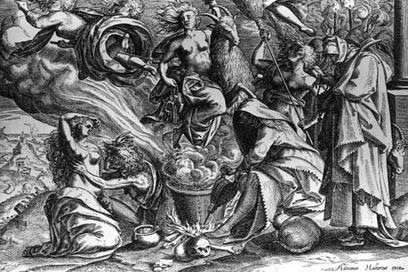 1484 Pope Innocent VIII issued the Summis desiderantes, a papal bull that deputized Heinrich Kramer and James Sprenger as inquisitors to root out alleged witchcraft in Germany and lead to one of the most oppressive witch hunts in European history.
1484 Pope Innocent VIII issued the Summis desiderantes, a papal bull that deputized Heinrich Kramer and James Sprenger as inquisitors to root out alleged witchcraft in Germany and lead to one of the most oppressive witch hunts in European history.

1536 The Pilgrimage of Grace against Henry VIII's Reformation was persuaded to disband by the duke of Norfolk.


63 BC Marcus Tullius Cicero, the consul of Rome, read the last of his Catiline Orations, exposing to the Roman Senate the plot of Lucius Sergius Catilina and his allies to overthrow the Roman government.

1349 Five hundred Jews of Nuremberg were massacred during Black Death riots.

1360 The French Franc was created.

1456 Earthquake struck Naples and about 35,000 died.
 1484 Pope Innocent VIII issued the Summis desiderantes, a papal bull that deputized Heinrich Kramer and James Sprenger as inquisitors to root out alleged witchcraft in Germany and lead to one of the most oppressive witch hunts in European history.
1484 Pope Innocent VIII issued the Summis desiderantes, a papal bull that deputized Heinrich Kramer and James Sprenger as inquisitors to root out alleged witchcraft in Germany and lead to one of the most oppressive witch hunts in European history. 
1536 The Pilgrimage of Grace against Henry VIII's Reformation was persuaded to disband by the duke of Norfolk.

Published on December 05, 2014 04:30
December 4, 2014
Ancient Pond, Bronze Fingernail Cleaner Hint at Roman Settlement
by Laura Geggel
Live Science
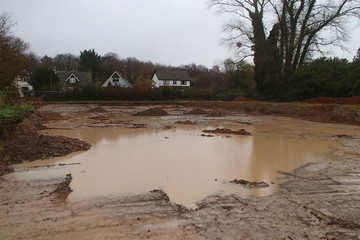
 Archaeologists found an ancient Roman Pond in southern England.
Archaeologists found an ancient Roman Pond in southern England.
Credit: Archaeology South-East
An ancient Roman pond, surrounded by bits of Roman pottery, garbage pits and even a bronze fingernail cleaner, was unearthed in Barnham, a village in southern England. The discovery provides evidence that Romans once occupied the region.
The artifacts, uncovered over the past several weeks, date back earlier than A.D. 100. Archaeologists found the pond on the last day of a survey that was required before construction could begin on a new housing development on the site.
"All the archaeological features appear today as filled with pale grey silt, and it is usually easy to see that these must be silted-up ditches, pits and post-holes," John Mills, West Sussex County Council’s senior archaeologist, said in a statement.
But one patch of silt, which formed a round "splodge" on the site, puzzled the archaeologists. On the last day of the excavation, they dug into the silt and found a shallow depression measuring about 1 foot (0.3 meters) deep and about 30 feet (9 m) wide. Although it's not lined with clay, as other Roman ponds were, it likely held water during the rainy seasons, Mills told Live Science. [Image Gallery: Trove of Roman Artifacts]
"It's unlined, so it couldn't have kept water all year round," Mills said. But the site is just a 5-minute walk from "a respectable stream," so the inhabitants likely didn't want for water, he added.
Perhaps the settlement's inhabitants used the pond as a watering source for livestock, such as cattle and sheep, he said. Archaeologists are now testing the soil to see what else they can learn about the site.
And while this was an unexpected find, unearthing ancient ponds is not all that infrequent, at least not on ancient Roman territory.
"In truth, I don't think that ponds are at all unusual on Roman rural settlement sites in Britain," Mills said. "On some Roman rural sites there were also waterholes, literally holes dug through natural clay down to the water table, sometimes with a step or two down to the standing water, to allow someone to pass up a bucket or other container from the surface of the water, just a few feet down."
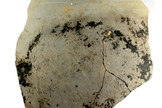
[image error] Pieces of pottery uncovered at the site, such as this Roman cooking pot, give clues about the area's early inhabitants.
Credit: Archaeology South-East
The Romans are known for their sophisticated water management. Archaeologists suspect that the ditches on the site served to drain water. People would have to periodically dig out these ditches as rainwater, and possibly groundwater, caused silt to accumulate in the ditch.
If a ditch could no longer function, people likely dug new ditches alongside the old ones, Mills said.
Although much of the site's drainage system is reminiscent of Roman technology, the settlement may have predated the Roman conquest of Britain in A.D. 43, during the Late Iron Age. Moreover, life in the settlement likely continued until well after A.D. 200, experts said.
Wealthy neighbor
Pottery fragments found at the site in Barnham suggest that the inhabitants got their goods from a variety of places. Their pottery may have been forged in kilns from the local Arun Valley, known for its thriving industry, and other goods may have been acquired from the nearby Rowlands Castle and New Forest areas, the archaeologists said.
Some of the pottery may have come from France, which was also part of the Roman Empire. Anyone who could afford fine tableware pottery likely had money or, at least, affluent connections, Mills said.
"They're not just simple farmers," he said. "Someone with money is somewhere in the background, otherwise the imported pottery wouldn't be there."
The archaeologists also found a decorated fragment of bronze, likely used for manicuring, or cleaning, a person's fingernails.
"[It's] something you wouldn't expect to find on a poor farmer's farmstead," Mills said. "Something is going on at that site. People are using it who have a good bit of leisure time."
Several flue tiles, used for underfloor heating in stone Roman buildings, also hint that an important Roman building was located nearby, possibly a bathhouse or the house of a wealthy person, Mills said.
"It may well be not far away at all," he said. But it's a "site that we haven't yet found."
Live Science

 Archaeologists found an ancient Roman Pond in southern England.
Archaeologists found an ancient Roman Pond in southern England.Credit: Archaeology South-East
An ancient Roman pond, surrounded by bits of Roman pottery, garbage pits and even a bronze fingernail cleaner, was unearthed in Barnham, a village in southern England. The discovery provides evidence that Romans once occupied the region.
The artifacts, uncovered over the past several weeks, date back earlier than A.D. 100. Archaeologists found the pond on the last day of a survey that was required before construction could begin on a new housing development on the site.
"All the archaeological features appear today as filled with pale grey silt, and it is usually easy to see that these must be silted-up ditches, pits and post-holes," John Mills, West Sussex County Council’s senior archaeologist, said in a statement.
But one patch of silt, which formed a round "splodge" on the site, puzzled the archaeologists. On the last day of the excavation, they dug into the silt and found a shallow depression measuring about 1 foot (0.3 meters) deep and about 30 feet (9 m) wide. Although it's not lined with clay, as other Roman ponds were, it likely held water during the rainy seasons, Mills told Live Science. [Image Gallery: Trove of Roman Artifacts]
"It's unlined, so it couldn't have kept water all year round," Mills said. But the site is just a 5-minute walk from "a respectable stream," so the inhabitants likely didn't want for water, he added.
Perhaps the settlement's inhabitants used the pond as a watering source for livestock, such as cattle and sheep, he said. Archaeologists are now testing the soil to see what else they can learn about the site.
And while this was an unexpected find, unearthing ancient ponds is not all that infrequent, at least not on ancient Roman territory.
"In truth, I don't think that ponds are at all unusual on Roman rural settlement sites in Britain," Mills said. "On some Roman rural sites there were also waterholes, literally holes dug through natural clay down to the water table, sometimes with a step or two down to the standing water, to allow someone to pass up a bucket or other container from the surface of the water, just a few feet down."

[image error] Pieces of pottery uncovered at the site, such as this Roman cooking pot, give clues about the area's early inhabitants.
Credit: Archaeology South-East
The Romans are known for their sophisticated water management. Archaeologists suspect that the ditches on the site served to drain water. People would have to periodically dig out these ditches as rainwater, and possibly groundwater, caused silt to accumulate in the ditch.
If a ditch could no longer function, people likely dug new ditches alongside the old ones, Mills said.
Although much of the site's drainage system is reminiscent of Roman technology, the settlement may have predated the Roman conquest of Britain in A.D. 43, during the Late Iron Age. Moreover, life in the settlement likely continued until well after A.D. 200, experts said.
Wealthy neighbor
Pottery fragments found at the site in Barnham suggest that the inhabitants got their goods from a variety of places. Their pottery may have been forged in kilns from the local Arun Valley, known for its thriving industry, and other goods may have been acquired from the nearby Rowlands Castle and New Forest areas, the archaeologists said.
Some of the pottery may have come from France, which was also part of the Roman Empire. Anyone who could afford fine tableware pottery likely had money or, at least, affluent connections, Mills said.
"They're not just simple farmers," he said. "Someone with money is somewhere in the background, otherwise the imported pottery wouldn't be there."
The archaeologists also found a decorated fragment of bronze, likely used for manicuring, or cleaning, a person's fingernails.
"[It's] something you wouldn't expect to find on a poor farmer's farmstead," Mills said. "Something is going on at that site. People are using it who have a good bit of leisure time."
Several flue tiles, used for underfloor heating in stone Roman buildings, also hint that an important Roman building was located nearby, possibly a bathhouse or the house of a wealthy person, Mills said.
"It may well be not far away at all," he said. But it's a "site that we haven't yet found."

Published on December 04, 2014 14:46
Giant Ancient Roman Water Basin Uncovered
by Rossella LorenziDiscovery News
 Italian archaeologists have unearthed the largest Roman water basin ever found, right in the heart of modern Rome.
Italian archaeologists have unearthed the largest Roman water basin ever found, right in the heart of modern Rome.
Found some 65 feet down near St. John in Lateran Basilica during the excavation of the new metro C line, the huge irrigation basin measures 115 feet by 230 feet.
“It’s so big that it goes beyond the perimeter of the metro work site. It has not been possible to uncover it completely,” Rossella Rea, the dig’s director, said at a news conference in Rome.
Photos: Ancient Water Basin Found in Rome
Rea, who led an all-woman team of archaeologists, noted the basin was lined with hydraulic plaster and most likely extends, still preserved, beyond the work site toward the ancient city walls.
“On the basis of the size that had been determined so far, it could hold more than four million liters (1 million gallons) of water,” Rea said.
The massive basin was part of a farm dating to the third century B.C. In the first century A.D., the basin was added to existing structures, such as water wheels, used to lift and distribute the water along canals.
“Most likely it served as a water reservoir for crops as well as an area that made it possible to cope with overflows from the nearby river,” Rea said.
‘Secret’ Labyrinth of Roman Tunnels Mapped
She believes the basin also extends towards the existing metro station of the A line, although most of the structure has been almost certainly destroyed.
The excavation, carried out by archaeologists Francesca Montella and Simona Morretta, also brought to light various agricultural related items, such as a three-pronged iron pitchfork, and remains of storage baskets made from braided willow branches.
Lined up jars with their ends cut open were recycled as water conduits. Used tiles were also recycled to make canals. They were inscribed with the encircled initials “TL” — evidence that the farm belonged to a single owner.
Peach pits revealed the agricultural plant featured the first cultivation of peach trees, imported from the Middle East.
Video: Can Math Equations Be A Form Of Art?
The farm was obliterated at the end of the first century A.D., its structures, including the water basin, demolished and buried.
Rea said some findings will eventually be put on display in the St. John’s subway station, while other artifacts will be moved to Rome museums.
Image: Part of the massive water basin unearthed in Rome: Credit: Soprintendenza speciale per i beni archeologici di Roma.

 Italian archaeologists have unearthed the largest Roman water basin ever found, right in the heart of modern Rome.
Italian archaeologists have unearthed the largest Roman water basin ever found, right in the heart of modern Rome.Found some 65 feet down near St. John in Lateran Basilica during the excavation of the new metro C line, the huge irrigation basin measures 115 feet by 230 feet.
“It’s so big that it goes beyond the perimeter of the metro work site. It has not been possible to uncover it completely,” Rossella Rea, the dig’s director, said at a news conference in Rome.
Photos: Ancient Water Basin Found in Rome
Rea, who led an all-woman team of archaeologists, noted the basin was lined with hydraulic plaster and most likely extends, still preserved, beyond the work site toward the ancient city walls.
“On the basis of the size that had been determined so far, it could hold more than four million liters (1 million gallons) of water,” Rea said.
The massive basin was part of a farm dating to the third century B.C. In the first century A.D., the basin was added to existing structures, such as water wheels, used to lift and distribute the water along canals.
“Most likely it served as a water reservoir for crops as well as an area that made it possible to cope with overflows from the nearby river,” Rea said.
‘Secret’ Labyrinth of Roman Tunnels Mapped
She believes the basin also extends towards the existing metro station of the A line, although most of the structure has been almost certainly destroyed.
The excavation, carried out by archaeologists Francesca Montella and Simona Morretta, also brought to light various agricultural related items, such as a three-pronged iron pitchfork, and remains of storage baskets made from braided willow branches.
Lined up jars with their ends cut open were recycled as water conduits. Used tiles were also recycled to make canals. They were inscribed with the encircled initials “TL” — evidence that the farm belonged to a single owner.
Peach pits revealed the agricultural plant featured the first cultivation of peach trees, imported from the Middle East.
Video: Can Math Equations Be A Form Of Art?
The farm was obliterated at the end of the first century A.D., its structures, including the water basin, demolished and buried.
Rea said some findings will eventually be put on display in the St. John’s subway station, while other artifacts will be moved to Rome museums.
Image: Part of the massive water basin unearthed in Rome: Credit: Soprintendenza speciale per i beni archeologici di Roma.

Published on December 04, 2014 14:38



